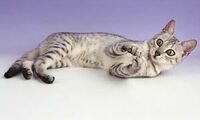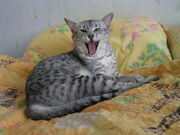| Egyptian Mau | ||
|---|---|---|
 | ||
| Information | ||
| Origin | ||
| Breed Standard | ||
| FIFe | ||
| CFA | ||
| TICA | ||
| AACE | ||
| ACF | ||
| CCA | ||
| Cat (Felis catus) | ||
| List of Cat Breeds | ||
The Egyptian Mau is a cat breed from Egypt. Unlike other cats, the Egyptian ones seem more nimble and jumpy.
Appearances
Egyptian Maus are a small-medium sized short-haired cat breed. They are the only naturally spotted breed of domesticated cat. The spots on an Egyptian Mau are not only just on the coat; a shaved Mau does, in fact, have spots on its skin. The spotted Mau is an ancient breed from natural stock; its look has not changed significantly as is evidenced by artwork over 3000 years old. Unlike other spotted cats such as the Ocicat or Bengal cat, the Egyptian Mau is a natural breed. Other breeds are created from domestic breed outcross or, in the case of the Bengal cat, domestic outcrosses with wildcats. The Mau is significantly smaller than these other breeds.
Physical information

Egyptian Mau.
The Egyptian Mau is the fastest of the domestic cats, with its longer hind legs, and unique flap of skin extending from the flank to the back knee, provides for greater agility and speed. Maus have been clocked running over 30 mph (48 km/h). Maus often possess very musical voices. They are known to chirp, chortle and emit other distinctly unusual vocalizations when stimulated.
Another behavior, quite common in happy Maus, has been described as "wiggle-tail." The cat, male or female, moves its back legs up and down, and appears to be marking territory, also known as spraying, but it is not actually releasing urine. Even veteran Mau owners are known to check after a joyous Mau does a little dance.
History and orgin

An Egyptian Mau yawning.
The exact origin of the Egyptian Mau is not recorded and therefore cannot be known for certain. The Egyptian Mau is often said to be descended from African wild cats, and an ancestor of the cats seen in wall paintings of Ancient Egypt.
The modern Mau is said to have originated in 1953, Italy, when exiled Russian Princess Natalie Troubetskoy met the cat of the Egyptian Ambassador to Italy. She convinced him to obtain several cats from Egypt for her, and she began to breed them. From her the Mau has been described as having a "troubled" look, with their round eyes and open expression. The Mau achieved championship status in some organisations in 1968. There were attempts by British breeders to create Maus from cross-breeds of Abyssinians, Siamese and tabbies, however these did not resemble the true Maus. This mix became the basis for the Ocicat. Egyptian Maus will either have a 'scarab beetle' or 'M' marking on their foreheads, those with the latter tend to be from the United States. Mau is Egyptian for cat, hence their name, Egyptian Maus.
Egyptian Maus are thought to be one of the progenitor breeds of the modern domestic cat. They have anatomical, metabolic and behavioral differences from other cat breeds which could be considered as evidence of antiquity or at least uniqueness from other cat breeds. Maus are more temperature sensitive than most breeds - they are fond of very warm temperatures. They are more sensitive to medicines and anesthesia. Maus allegedly have an unusually long gestational period, about 73 days. The maximum normal period for cats is 65–67 days, although Siamese may take a day or two longer.
Albeit largely anecdotal, the Egyptian Mau is well known for intelligence and close bonding with responsible and loving owners. Such owners typically report their Maus eagerly greet them at the door at the end of a long day at work. Usually requiring more effort than other breeds, Maus can be "lap cats," but their alert nature makes the task difficult, yet far more rewarding once accomplished. Although ill-advised by most veterinarians and animal-care givers, the Egyptian Mau loves an outdoor life. Their speed, coupled with their innate intelligence, allows them to avoid almost all dangers if carefully introduced to an outdoor world very early in life. Unusually averse to loud noises and fast-moving objects, Maus are rarely "road kills," and instead are far too busy decimating the mouse and rat population in the back yards and farms of your neighbors. Many responsible farmers report that a few Mau crossbreeds have saved entire crops from rodents. The typical Mau is not social with strangers of any species, other cats in particular. As kittens, maus will also test out their ability to attack and scratch. Providing them with large sausage-like dog toys so they can practice "gutting" and "killing" is a must if you want your cat to be a ratter. Also, they are very hard to wash if you do not have thick gloves or thick skin/big gloves. Maus will fight trespassing cats with astonishing ferocity and uncannily disappear from strange and loud humans. Accordingly, the Egyptian Mau is not a good choice for an absentee condo owner who, when home, brings in strange pets and humans.
Trivia
- In Ancient Egyptian Mau means Cat.
- They were one of the first known domestic cats.
- They are featured in the 39 clues series.
